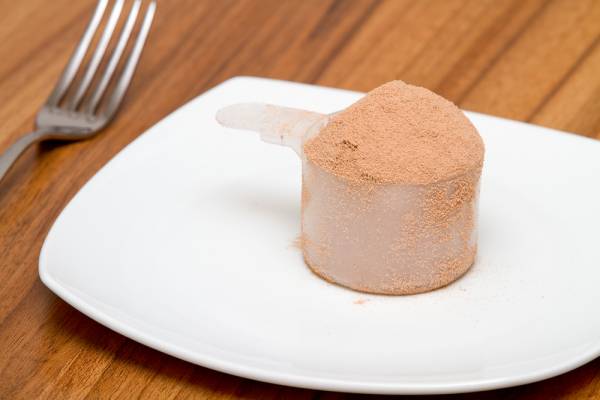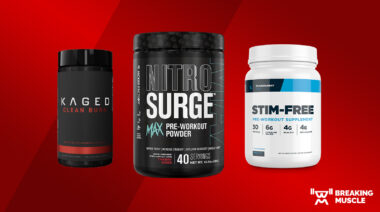When you go supplement shopping, have you ever actually looked at what type of protein you’re buying? I typically purchase whey protein, but there are other proteins out there, specifically casein.
As humans, we can break down all the different types of protein, but for this article we will keep it simple and look at the two most-purchased proteins – whey and casein. You will learn how each protein acts in the body and how each has a unique benefit to you as an athlete.
RELATED: 4 Things You Need to Know Before Buying Supplements
The Science of Protein
All proteins contain carbon, hydrogen, oxygen, and nitrogen. Some proteins even have sulfur in them. These elements make up the building blocks of proteins – the amino acids. There are twenty basic types of amino acids.
Proteins are composed of both essential and nonessential amino acids:
- Essential amino acids must be obtained through food as the body cannot synthesize these.
- Nonessential amino acids are still important to construct our body’s proteins. The name just means it is not necessary for us to ingest them because our bodies can synthesize them.
The Effects of Calorie Intake and Training
Protein can be metabolized as a source of energy when you are experiencing a negative caloric balance. That means when you eat fewer calories than you expend.
There is an inverse relationship between your caloric intake and your actual protein requirement. When caloric intake goes down, protein requirement goes up and vice versa. In addition, individuals who have a negative caloric balance and consume lower-quality proteins will need an even higher amount of protein than would normally be consumed.
“There is an inverse relationship between your caloric intake and your actual protein requirement. When caloric intake goes down, protein requirement goes up and vice versa.”
For athletes, protein requirements are increased due to training. Both aerobic endurance training and resistance training can increase protein need. For aerobic athletes, protein is required for tissue repair and the use of branched-chain amino acids for fuel. For strength athletes, protein is required for tissue repair, along with the maintenance of a positive nitrogen balance.
RELATED: Let’s Talk About Protein: When, Where, and How Much Do You Need?
Okay enough of the biology, right? Let’s get down to the meat and potatoes of this article – should you use whey or casein protein and why?
Whey Protein – The Facts
You will see whey protein the most in the supplement stores. Whey is a component of cow’s milk and accounts for about 20% of its protein content. Interestingly, most whey is produced as the byproduct of cheese manufacturing. (Remember Little Miss Muffet?)
Whey protein includes all the essential amino acids (remember those?) and is especially high in branched-chain amino acids, which are key for muscle protein synthesis. Whey protein has more sulfur-containing amino acids than its counterpart, casein. Because of this trait, it has a slightly higher level of biological utilization than other proteins.
“Interestingly, most whey is produced as the byproduct of cheese manufacturing.”
Whey is considered a fast protein source. It digests fairly quickly, which causes a rapid increase in amino acid levels in the body. After consuming whey protein, blood amino acid levels peak at around sixty to ninety minutes after ingestion. This peak is short lived and is not sustained past two to three hours.
When protein floods the body with amino acids in this way, some of the protein is oxidized or wasted as excess. Since whey protein is so quickly digested, this is the protein you want to use right after your training session. This is because your muscles have broken down from your workout, and since whey protein is so fast acting, it can aid in muscle repair by increasing muscle synthesis.
RELATED: Post Workout Nutrition: Carbs Only? Or Carbs + Protein?

Casein Protein – The Facts
This type of protein is the most abundant form in cow’s milk, accounting for about 80% of its protein content. All forms of casein contain a high-quality blend of essential, nonessential, and branched-chain amino acids. Unlike whey, casein contains a fairly low percentage of branched-chain amino acid and has a lower biological utilization rate.
Casein is a slow-digesting protein. The body digests casein’s amino acids in a steady manner that keeps their levels well maintained after ingestion. Thus, casein produces a stable elevation of amino acids that lasts for up to seven hours.
Casein does not have an amino acid spike like whey protein does. Therefore, less protein is oxidized or wasted. Because of this, casein increases protein synthesis to a lesser extent than whey, but reduces whole body protein breakdown. Casein produces greater positive overall protein balance compared to whey. Casein is usually known as “anti-catabolic” because of this slow acting nature.
Casein is ideal for nighttime use or as a meal replacement, when you know you will not eat for three hours. Since casein is so slow acting, it is not ideal for your post-workout protein. This is because your muscles will not get the immediate benefit of muscle repair shortly after exercise, like they can with whey ingestion.
RELATED: Why Proper Sleep and Melatonin Are Absolutely Essential
Casein is better used at bedtime. While you sleep, you have the greatest opportunity for muscle repair, and casein can aid in that type of repair throughout the night since it produces seven hours of steady elevation of amino acids.
Protein and Appetite
Many people use proteins as a way to suppress appetite or as a way to replace a meal. Is one better than the other in this regard?
The British Journal of Nutrition did a study to answer this question. The object of the study was to compare the effects of hydrolyzed casein (HC), intact casein (IC), and intact whey (IW) on energy expenditure (EE) and appetite regulation.
In this randomized, cross-over study, 24 overweight and moderately obese young men and women consumed three equally active dietary treatments that varied in protein source. The study was conducted in a respiration chamber, where energy expenditure, substrate oxidation, and subjective appetite were measured over 24 hours at three independent visits.
RELATED: Lose Weight With Smaller Plates: Science Weighs in on Dishsize and Calories

The results showed no difference in dietary treatments between 24 hours and the period after dinner or lunch when it came to energy expenditure or appetite regulation. But the study did show that lipid oxidation (fat loss/waste) – estimated from the respiratory quotient, which is used in calculating basal metabolic rate – was found to be higher after the consumption of intact whey than the consumption of hydrolyzed casein during the daytime, as well as after breakfast meals.
“So basically, none of the proteins tested varied when it came to regulating appetite or increasing your body’s energy expenditure. But they did differ when it came to fat loss.”
So basically, none of the proteins tested varied when it came to regulating appetite or increasing your body’s energy expenditure. But they did differ when it came to fat loss. Based on this study, it seems you may have more fat-burning capabilities if you ingest intact whey in the morning.
Summary
Many people in the fitness realm use some sort of supplementation on a daily basis. Protein is by far the most popular. But if you don’t know what type of protein you are consuming, you might be getting in the way of your own fitness goals.
To keep it simple:
- Whey is perfect for the morning hours and as your post-workout protein for muscle repair.
- Casein is perfect for your nighttime muscle repair.
Also, just like any other food or substance you put in your body, always choose a quality protein. You will usually regret if you go cheap.
References:
1. Bendsten, LQ. et.al “Effects of Hydrolyzed Casein, Intact Casein, and Intact Whey on Energy Expenditure and Appetite Regulation: a Randomized, Controlled, Cross-Over Study.” The British Journal of Nutrition (2014): 1412-1422, accessed November 16, 2014, doi: 10.1017/S000711451400213X.
2. Llewellyn, W. Sport Supplement Reference Guide. (Florida: Molecular Nutrition, 2009), kindle edition.
3. Baechle, Thomas R., Earle, Roger W. (2008). Essentials of Strength Training and Conditioning. Nebraska. Human Kinetics 207-208.
4. Tate, P., Seely’s Principles of Anatomy and Physiology. (New York: McGraw Hill Companies, 2012), 37-38, 694.
5. Abrahams, P., How the Body Works. (New York: Metro Books, 2007), 260.
Photos courtesy of Shutterstock.






